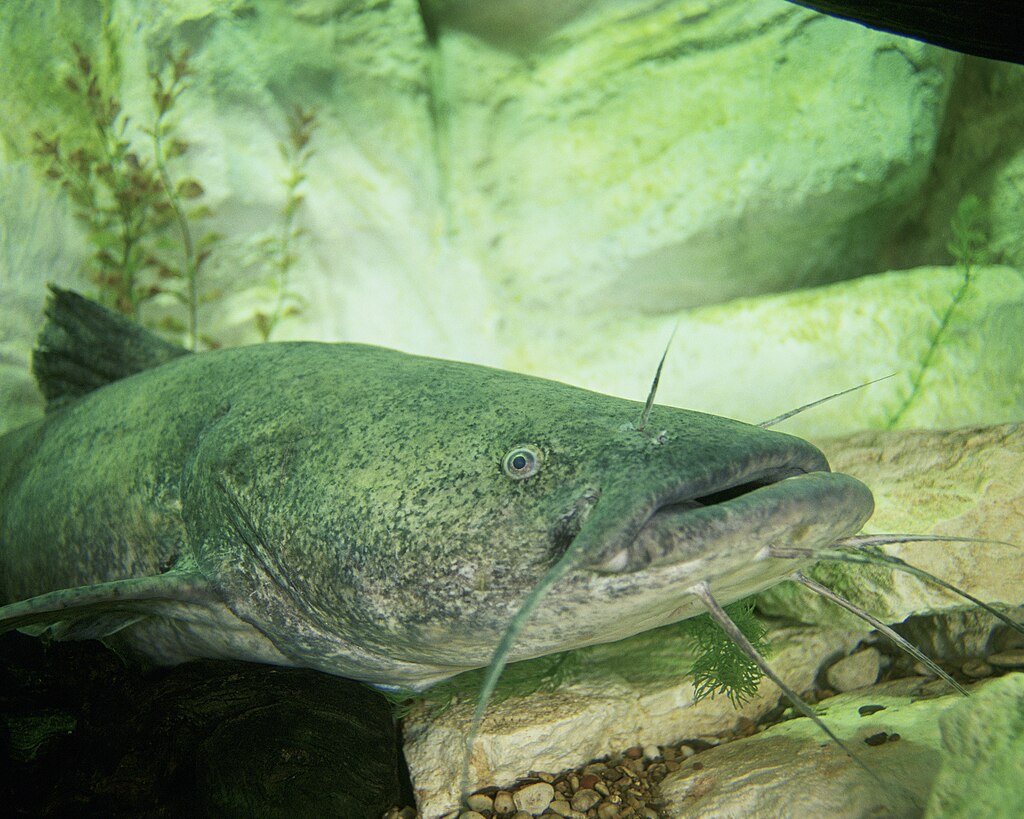
Flathead Catfish
Scientific Name: Pylodictis olivaris
Also known as: Yellow Cat, Opelousas Cat, Shovelhead Catfish, Mud Cat, Appaloosa Cat
General Description
The flathead catfish is a large, predatory species native to the central United States. Known for its distinct, broad, and flattened head—hence its name—this catfish has a body that tapers to a long, slender tail. Its coloration typically includes olive, brown, or yellowish hues, which help it blend into its river or lake environment. Flathead catfish can grow to impressive sizes, with some individuals reaching lengths of up to 4 feet and weighing over 100 pounds, although the average catch tends to be much smaller. They have a smooth, scaleless body and long barbels around their mouth that help them locate prey in murky water. These catfish are aggressive feeders and primarily hunt live prey, including fish and smaller invertebrates. They are a sought-after species for sport fishing due to their size, strength, and the challenge they present when hooked.
Flathead catfish are nocturnal feeders, often active during the evening and night when they leave their daytime resting spots to hunt for food. They are solitary by nature, with each individual typically establishing a home range in deep, slow-moving waters with plenty of structure like fallen trees, submerged rocks, and deep holes.
Where to Find Them
Flathead catfish are found primarily in the eastern and central United States, particularly in the Mississippi River Basin, and have been introduced into several other river systems across North America. They are typically found in larger rivers, reservoirs, and lakes with slow-moving waters, where they can hide in deep holes, submerged logs, and rocky structures. These catfish are less likely to be found in fast-moving streams or shallow waters, preferring the cooler, deeper, and more turbid habitats where they can hunt effectively.
They are commonly found in both freshwater rivers and reservoirs, with a preference for areas where the bottom of the water body is covered with rocks, logs, or other submerged structures. Flathead catfish are often located near drop-offs or in the deeper sections of lakes and reservoirs, especially during the daytime when they seek refuge in the cooler, deeper waters. They are primarily nocturnal, so fishing for them at night or during dusk and dawn is often the most successful strategy.
In rivers, flathead catfish can be found in slow-moving stretches or eddies behind large rocks, submerged debris, or deep pools. They are ambush predators, waiting patiently near structures to strike at prey that comes close. When fishing in lakes and reservoirs, locating deep holes near the shoreline or submerged objects is key to finding flathead catfish. They are also attracted to warmer waters during the summer months and may move to shallower areas for spawning.
Best Baits
Live Bait Options
- Small or medium-sized bluegill
- Shad (live or cut)
- Small carp
- Goldfish
- Sunfish
- Mud minnows
Artificial Bait Options
- Large soft plastic worms or lizards
- Big rubber frogs
- Large swim baits
- Soft plastic swimbait trailers
- Jigging spoons (large)
- Heavy-duty crankbaits
Best Fishing Methods
Fishing for flathead catfish requires patience and knowledge of their habitat and feeding behavior. The best way to target flathead catfish is by using live bait, especially smaller fish like shad, bluegill, or sunfish. These baits can be fished near the bottom using a basic bottom rig or suspended on a slip-sinker rig. Flathead catfish are ambush predators, so placing the live bait near submerged structures like fallen trees, rocks, or deep holes is key to attracting their attention.
For anglers targeting flatheads, using large, heavy tackle is essential due to the size and strength of these fish. A sturdy rod, high-test line (at least 20-30 lb test), and a strong hook are necessary to successfully land a large flathead. The fish often strike aggressively, so it’s important to have the right gear to withstand the fight. In deeper waters, flathead catfish are often found near drop-offs or other underwater structures, so fishing at varying depths with live bait can be an effective strategy.
Artificial lures like large swimbaits, rubber frogs, and soft plastic worms can also be used to target flathead catfish, though live bait tends to be more effective. These lures are often fished with a slow, steady retrieve to mimic the movement of smaller prey. For night fishing, topwater lures like frogs or large poppers can produce explosive strikes when cast near submerged structures or around areas with abundant cover.
Since flathead catfish are more active at night, fishing during the evening or early morning hours can significantly increase your chances of success. Night fishing with a bright lantern or headlamp will help you locate your rig and attract the fish to your bait.
Summary
Fishing for flathead catfish is a thrilling and challenging pursuit that requires knowledge of their behavior and habitat. These catfish are solitary predators that prefer deep, slow-moving waters with plenty of submerged structures where they can ambush their prey. They are nocturnal feeders, which means the best time to fish for them is during the evening and night when they are most active.
Flathead catfish can be caught using a variety of methods, but live bait like shad, bluegill, or small carp is often the most effective. Fishing with heavy-duty tackle is essential to handle the size and strength of these fish, as they can put up a tough fight when hooked. Artificial lures like large swimbaits or soft plastics can also be effective, though they may require more time and effort to land a catch.
To increase your chances of success, focus on fishing around submerged structures like fallen logs, rocks, or drop-offs in rivers, reservoirs, and lakes. As flathead catfish tend to be deep-water dwellers during the day, targeting them in the evenings and early mornings can improve your chances of success. Whether you’re fishing from a boat or casting from the shore, patience and persistence are key to catching a flathead catfish.


